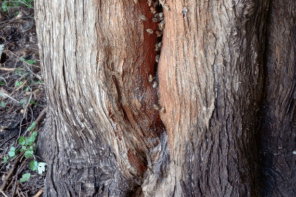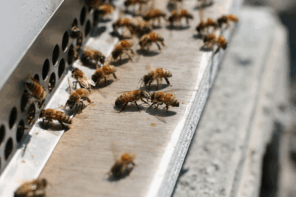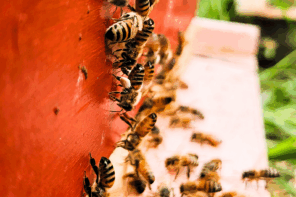Click Here if you listened. We’re trying to gauge interest so only one question is required; however, there is a spot for feedback!
Read along below!
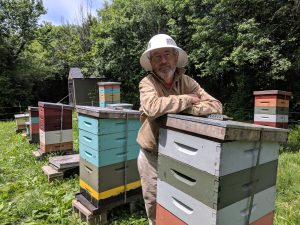
The Electrical World of the Honey Bee
By: Ross Conrad
It has been said that honey bees have been studied and written about more than any other subject second only to ourselves. Certainly our deep understanding of bees is part of what makes them so fascinating. Yet for all we know about bees, there’s much we still do not understand. One area of inquiry in which we have only scratched the surface of our knowledge is the role electricity plays in the life of the colony.
It is well established that insects become electrostatically charged when walking, or when their body parts are rubbed together (Colin and Chauzy, 1991) and insect cuticles in general display the tendency to become positively charged (Edwards, 1962). This phenomenon is similar to the static electricity generated when we walk across a wool carpet or rub an inflated balloon against our hair.
It is also clear that bees become charged with a weak electric charge when flying through the air. How this occurs is not clear however. There are two main theories why this happens. One is that it is a result of friction. The other is that the flying bee picks up positively charged ion particles (cations) from the air. Which one is true? Do both potential charging methods play a role? We do not know. What we do know is that since bees are quite small, they experience weak electrical fields much more profoundly than we do.
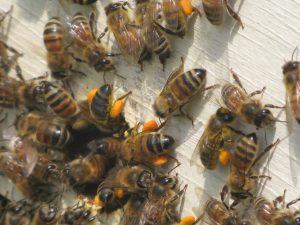
The static electric charge that builds up on the bee’s body while it flies greatly increases its pollen collecting efficiency.
Flowers are electrically connected to the earth and pick up a negative charge through electrostatic induction. Bees pick up a positive charge as they fly through the air. The bee’s body surface charge appears to facilitate pollination since flowers are negatively charged and bees are positively charged (Greggers et. al., 2013b). The attraction of pollen to bees due to their opposite polarity allows pollen to defy gravity, moving against the earth’s gravitational forces in order to stick to the surface of the bee and become lodged in its body hairs (Clarke et al., 2017).
The acquisition and maintenance of charge on a bee appears key to their ability to detect electric fields such as that on a flower (Sutton et al., 2016). While it seems clear that the static electric charge aids in pollen collection by foragers, do these electrical forces (between bee and flower) allow the forager to also assess floral rewards and perhaps allow them to tell which flowers have been recently visited by another pollinator and which have not and therefore which blossoms are worth taking the time to investigate and which are a waste of time?
Some research indicates that the change in electrical charge created by pollinator visits to blossoms stimulate some flowers to release more of their scent thus increasing their chances of being pollinated (Montgomery, 2021). Since flowers have a limited supply of scent, some appear to prefer to release it when pollinators are around – after all, it makes sense that the best time to advertise is when you know you have an audience.

Electrostatic dusting is used to reveal areas of the greatest negative charge density on each flower. Flowers are shown before (left) and after (right) dusting with positively charged colored powder of blue or yellow (bottom image). Photo credit: Concept and Pictures by D. Clarke & D. Robert
Meanwhile, agrichemicals such as synthetic fertilizers and the neonicotinoid imidacloprid have been shown to effect bumblebee foraging behavior by changing the magnitude and dynamic of electrical cues given off by the treated blossoms. Researchers found that the biophysical responses in the plants modified floral electrical fields appeared to disturb the ability of the bees to sense the electrical fields causing them to approach the electrically manipulated flowers less often, land on the flowers they did approach less and this reduced bumblebee foraging efficiency (Hunting et al., 2022). The bioelectrical potential of the chemically treated flowers were impacted for a longer duration than the changes observed by natural phenomena like the wind or a bee landing on the flower. This raises questions about what other pesticides might influence the electrical fields of flowers.
Honey bees appear to perceive weak electrical fields through the two joints of the antennae johnston’s organ (Greggers et al. 2013a). Bumblebees can also detect electrical fields with their antennae but appear to do so more effectively using their body hairs (Sutton et al., 2016). Like a sapling bending in the wind, the bee hairs and antennae alert the bee to oppositely charged electric fields. Do honey bee hairs or other rigid cantilevered body parts, carrying an electric charge and subject to external electrical force, also bend toward (or away) from electrically charged objects?
Bees appear to detect and use aerial electric fields not only in the context of foraging but also during in-hive communications over short distances. Research suggests that part of the waggle dance includes low-frequency oscillating electrical stimuli from electrically charged vibrating foragers to yet to be recruited foragers while doing the dance (Greggers et al., 2013b). Does the honey bee use its antennae for other forms of electroreception communication as well? Exactly how bees respond, learn from or exploit electrical fields in their natural habitat and within social contexts is not entirely clear. For example, how does rain, high humidity or winds impact floral electrical fields?
Since each bee carries with it a small electrical charge, what happens when a large group of them swarm? A recent study suggests that honey bees contribute to atmospheric electricity in proportion to the size and density of the swarm that issues from a colony. Researchers calculated that the swarm had enough charge to affect the atmospheric electric field known as the potential gradient, which is the voltage difference between the earth’s surface and a point (often one meter) above it. The effect was proportional to the swarm density. Similar impacts can be observed in swarms of locusts, although their impact is much greater since locust swarms can cover hundreds of square miles and pack between 40-80 million locusts in less than half a square mile. The study authors hypothesize that insects can have similar effects on atmospheric electricity as weather events since at the ground level where they made their measurements; the strength of the honey bee swarm’s electric field was comparable to the kinds of changes in electric fields that we see during a thunderstorm (Hunting, 2022).
Does this mean we need to include the role of insects in geological modeling of atmospheric changes? Scientists have long wondered about what forces can carry sand particles from the Sahara desert across oceans. Could atmospheric changes brought on by the electric fields given off by insects help to explain the long distance dust transportation that has been documented in nature that cannot be explained by physical processes such as wind and updrafts alone (Toth et al., 2020; Does Van der et al., 2018)? Perhaps the charged up bee’s electrical fields add to the electrifying effect the sight of a swarm has on us beekeepers?
So many questions; so few answers, and this is just one small area of inquiry into the amazing and mysterious world of the honey bee.
References:
Colin, M.E., Chauzy, D.R.S. (1991) Measurement of electric charges carried by bees: evidence of biological variations, Journal of Bioelectricity, Vol. 10(1-2), pp. 17-32
Does Van der, M., Knippertz, P., Zschenderlein, R., Harrison, G., Stuut, J.B.W. (2018) The mysterious long-range transport of giant mineral dust particles, Science Advances, 4(12)
Clarke, D., Morley, E., Robert, D. (2017) The bee, the flower, and the electric field: Electric ecology and aerial electroreception, Journal of Comparative Physiology. A Neuroethology, Sensory, Neural, and Behavioral Physiology, 203(9): 737-748
Edwards, D.K. (1962) Electrostatic charges on insects due to contact with different substrates, Canadian Journal of Zoology, 40:579-584
Greggers, U., Koch G., Schmidt, V., Dürr, A., Floriou-Servou, A., Piepenbrock, D., Göpfert, M.C., Menzel, R. (2013a) Reception and learning of electric fields in bees, Proceedings of the Royal Society B, 280: 20130528. Doi:10.1098
Greggers, U., Koch G., Schmidt, V., Dürr, A., Floriou-Servou, A., Piepenbrock, D., Göpfert, M.C., Menzel, R. (2013b) Reception and learning of electric fields in bees, Proceedings of the Royal Society B, 280(1759): 20130528. Doi:10.1098
Hunting, E.R., O’Reilly, L.J., Harrison, R.G., Manser, K., England, S.J., Harris, B.H., Robert, D. (2022) Observed electric charge of insect swarms and their contributions to atmospheric electricity, iScience, 25(11)
Hunting, E.R., England, S.J., Koh, K., Lawson, D.A., Brun, N.R., Robert, D. (2022) Synthetic fertilizers alter floral biophysical cues and bumblebee foraging behavior, PNAS Nexus, vol.1 (5)
Montgomery, C., Vuts, J., Woodcock, C.M., Withall, D.M., Birkett, M.A., Pickett, J.A., Robert, D. (2021) Bumblebee electric charge stimulates floral volatile emissions in Petunia integrifolia but not in Antirrhinum majus, The Science of Nature, 44:108
Sutton, G.P., Clarke, D., Morley, E.L., Robert, D., (2016) Mechanosensory hairs in bumblebees (Bombus terrestris) detect weak electric fields, Proceedings of the National Academy of Science, 113(26): 7261-7265
Toth, J.R. III, Rajupet, S., Squire, H., Volbers, B., Zhou, J., Xie, L., Sankaran, R.M., Lacks, D.J. (2020) Electrostatic forces alter particle size distributions in atmospheric dust, Atmospheric Chemistry and Physics, 20.5: 3181-3190







